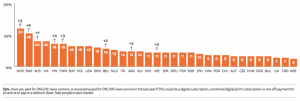Blog
Reuters Institute Digital News Report 2018 – Key Findings
11 July 2018
The highly anticipated 2018 Reuters Institute Digital News Report was released last month, once again packed full with industry insights and informative data. PageSuite has deciphered the 144-page study to highlight three of the key findings to discuss how these future trends are going to affect publishers.
Readers are paying for news
As publishers continue to persuade readers into paying for their content, the hard work is showing signs of paying off. The average number of people paying for online news has increased, especially those smaller markets who have a strong tradition for reading and subscriptions. This is particularly the case for Nordic countries who lead the world in paying for online news. Readers within this territory have an average of 22% willingness to pay for news, with Norway (30%), Sweden (26%), and Finland (18%) continuing to grow. All publishers within this territory implement an assortment of paywall strategies, compared to other fragmented markets such as the UK and Germany where many publishers still offer online news content for free.

The USA has managed to sustain last year’s ‘Trump Bump’ with 16% of readers paying for some form of online news content. This is not the same story for the UK, persuading users into a paid for culture has been a slow transition with only 7% willing to pay in the UK.
Fake News
Fake news remains a major concern for readers, with 58% of respondents concerned that the news they consume is completely made up. However, the Reuters reports identified that when consumers talk about ‘fake news’ they are often just as concerned about poor journalism, clickbait, or biased/spun journalism. The report explains this is the ‘type of misrepresentation that readers say they are most often exposed to (42%).’ The proportion of readers that are extremely concerned about what is real news and what is fake differs considerably depending on which country. As you can see from the below graph certain political events trigger a concern about what is fake news, this is particularly the case for Brazil, Spain and USA.

According to the report as a general overview, the average level of trust in the news remains relatively stable at 44%, with over half agreeing they trust the news media that they use. Trust in social media for the first time has seen a decline, with only 23% of readers saying they trust the news found in social media. This decline reflects the relationship that Facebook and news which is proving even more unreliable.
Voice-activated devices
The emergence of voice-activated devices has been a significant driver for the demand of audio news content. Digital assistants such as Google Home and Amazon Echo continue to rapidly grow with almost one in ten (9%) now using them in the United States, 7% in the UK, and 5% in Germany. Around half of those who have voice-activated devices are using them for news and information.

Other Noteworthy Points
Donations and Membership are emerging as an alternative to subscription models for smaller organisations. According to the report, only 1% donate today but 22% said they may do in the future, which is worth publishers considering. The Guardian continues to adopt this strategy, since 2016 the newspaper has received over 600,000 voluntary payments which the newspaper continues to stick with.
There has also been a resurgence in readers using ad blocking software which is negatively affecting publishers. After ad blocking software seemed to plateau last year, this year has seen another significant rise – globally 27% of readers are using ad blockers. The saving grace for publishers is that only 10% of mobile news readers are using ad blockers compared to 14% on tablet and 31% on desktop.
Keep an eye out for future posts as we continue to analyse the report. You can download the full Reuters Institute Digital News Report 2018 here.





